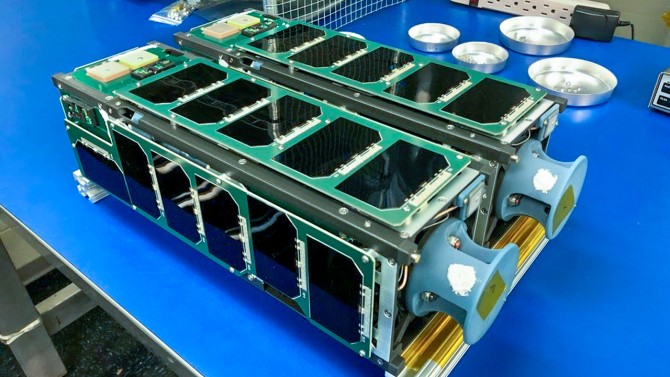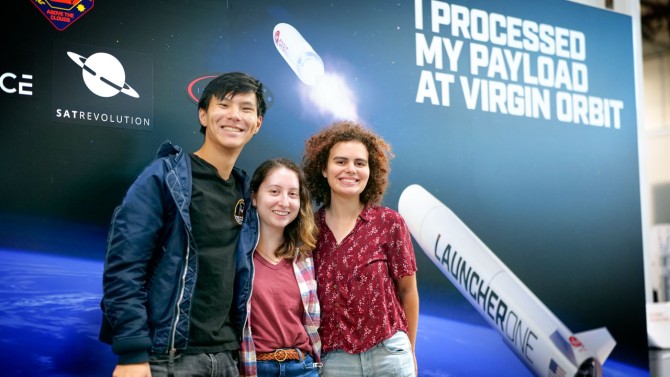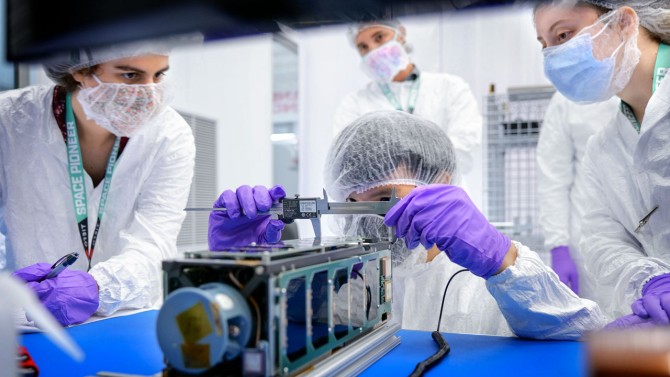Student-built CubeSats to rendezvous in space
In the future, mass transportation will almost certainly involve self-driving vehicles. The aerospace industry is pushing that idea even further, all the way to space, but the results for autonomous small spacecraft have been mixed.
Now, a Cornell Space Systems Design Studio project that demonstrates the technology’s potential is poised to take flight aboard a VOX Space rocket, with the help of the U.S. Department of Defense Space Test Program.
The Pathfinder for Autonomous Navigation (PAN) project, led by Mason Peck, the Stephen J. Fujikawa ’77 Professor of Astronautical Engineering in the College of Engineering, is preparing to launch a pair of small, low-cost, modular satellites, known as CubeSats, into space. Once deployed in low Earth orbit, the two CubeSats will drift apart by up to 30 kilometers and then, using custom software, locate each other’s position, fire their thrusters and dock together.
By demonstrating that autonomous rendezvous and docking are possible at the small spacecraft scale, the project provides a critical step towards the eventual construction of advanced structures such as space stations, as well as the refueling and repairing of small spacecraft.
“As time goes on, there’s more and more commercial use of space,” said Peck, the director of the Space Systems Design Studio. “A spacecraft that can autonomously handle its own affairs – specifically docking or navigating – will enable this future where we don’t have hundreds of people in a mission control center, artisanally controlling every spacecraft, which is not sustainable, and it’s also very expensive. This really has not been done successfully at this scale.”
CubeSats are essentially modular units designed with a widely recognized set of specifications that can conform to a host of technical requirements. Not only do CubeSats provide mission flexibility, they are also small, low-cost and can be launched relatively easily.
The project, which is part of NASA’s CubeSat Launch Initiative, began to take shape in Peck’s lab in 2016. Construction and mechanical testing were completed in 2019, and the work has since focused on developing the spacecraft’s software.
PAN consists of two nearly identical CubeSats, each 10 by 10 by 30 centimeters, which technically means they are cubes in name only. Among their most innovative features are a unique docking apparatus with magnets and motors that allow the spacecraft to use magnetism to dock, thereby conserving power; an attitude control subsystem that manages the CubeSats’ orientation; and a cold-gas propulsion subsystem that is fueled by refrigerant and incorporates many 3D-printed components.
“The general industry trend in the past has been to just buy extremely high-cost and high-precision components,” said Shihao Cao ’23, one of the students who worked on the project and served as a team lead, along with Andreea Foarce ’22. “We wanted to change that. Whenever possible, we opted for lower-precision components that are cheaper and easier to work with and design around, and then we compensate with advanced software.”
This innovative, low-cost approach will not only enable more custom-made CubeSats, but also a broader and more democratized use of space, Peck said.
All the hardware and software were designed and built at Cornell by Peck and his students, who, as a result of the intensive labor and scientific rigor that are required for constructing a spacecraft, have developed a particularly personal connection to the project, one that has uniquely prepared them for careers in the aerospace industry.
Foarce went so far as to drive the CubeSats across the country this summer with her father and a friend – 47 straight hours from Ithaca to Los Angeles – to ensure the project arrived at its final (terrestrial) destination without being damaged in transit.
“It was very exciting to see it all come together,” Foarce said, “but also kind of nerve-racking, because we’re letting all that hardware go that we know so many people have worked on, and so many people who we look up to. We’re representing the whole team.”
In October, Cao, Foarce and PAN’s mechanical lead Millie Schwartz ’23 flew out to Los Angeles to integrate the spacecraft onto the payload stack of a VOX Space rocket, which is scheduled to launch in early 2022.
The CubeSats will be deployed several hundred kilometers above the surface of the Earth and will naturally drift apart. Meanwhile, Peck’s team will handle the mission operations from the ground, monitoring the CubeSats – nicknamed “Leader” and “Follower.” The satellites will communicate their respective locations, either directly to each other or by sending the information to the team on the ground, who will relay the information back up to the other satellite. Follower’s software will compute the distance and its onboard thrusters will fire, causing the satellite to close the gap and eventually dock with its partner.
“The ground is not actually calculating any of the exact maneuvers,” Cao said. “The satellites, with knowledge of where the other one is, will find their way to each other.”




